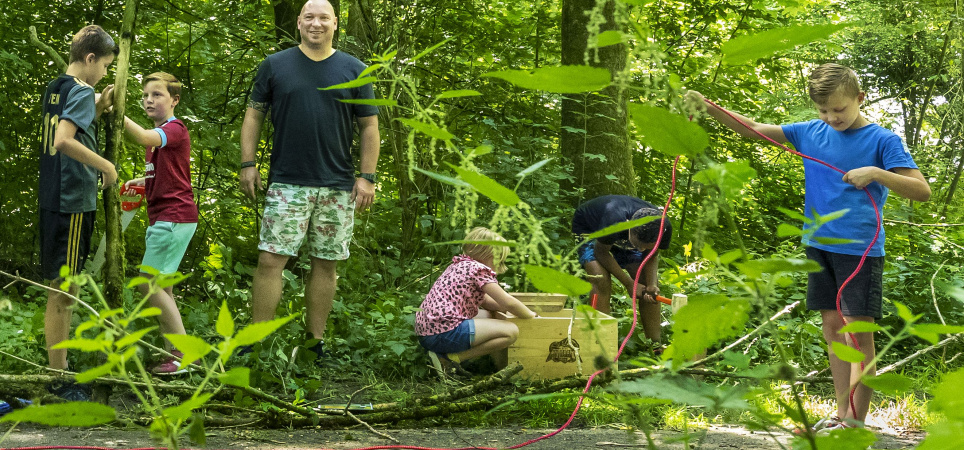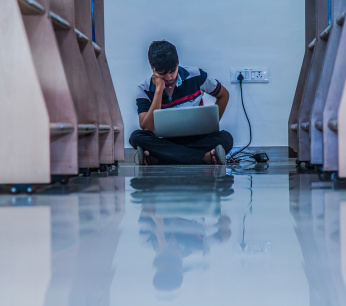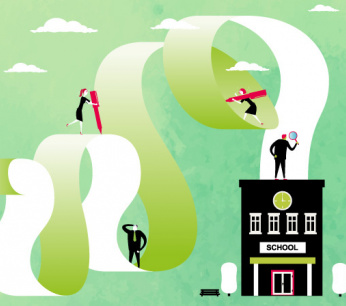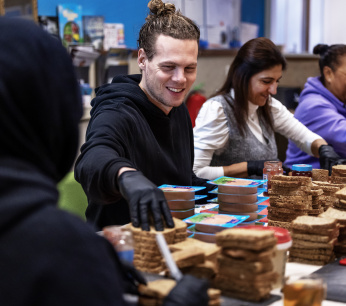Idea: Your own kingdom in the bushes
By having children build huts together, you work on their motor skills, problem-solving ability, social skills and their health, discovered gym teacher Rutger Verhagen. With his concept Hutcraft, he is now even organizing an NK.

Image: Angeliek de Jonge
“In recent years, I have noticed more and more during my PE lessons that students have less motor skills, for example in the salto learning line or on the inflatable tumbling track,” says PE teacher Rutger Verhagen of the Lorentz Lyceum in Arnhem. “And what I also notice is that as PE teachers, we actually just go along with it and make increasingly lower demands on our students.”
So when Verhagen had to come up with an issue for his master's program in sport and exercise innovation - something he thought could and should be done differently - he didn't have to think long. “I see that children now sit much more than seventeen years ago when I started as a gym teacher. The causes are known: gaming, smartphones and social media. But is that really the case, I wondered. Or am I just getting old?"
In recent years I have noticed that students have less motor skills
less outside
To find out, Verhagen first conducted a literature study. He read national and international studies, and indeed, they showed that Dutch children are European champions of sitting still. “The biggest cause turned out to be that children play outside less often these days. As a result, they have less motor skills and they also lag behind in other matters. Think of social skills (you usually play outside with others), problem-solving ability (how do children get the ball back from that angry neighbor's garden?) and their health (because children are less exposed to daylight, their eyesight deteriorates). ”
Dutch children are European champions sitting still
During his literature research, Verhagen discovered even more factors that play a role in this trend. “In the Netherlands we over-regulate everything. For example, playgrounds must meet all kinds of safety requirements, so that children are not challenged. For a child of five years, such a playground is often no longer an issue. You also see that children skateboard, roller skate, lolo balls and curbs less because their parents do not think the residential area is safe because of the busy traffic. Some find it so dangerous that they drive their children to school, making the problem even worse.”
After Verhagen had made the problem clear, he listened to fellow teachers, marketeers, municipal officials and scientists. “I spoke to social psychologist Regina van der Eijnden, who explained to me that online games respond to three basic needs of children: competence, connectedness and autonomy. Children notice that they get better at the game (because they level up again), they see that others can also follow them online and they can make their own choices in the game: do I go left or right, on which level do I play? the game? This applies not only to games, but also to social media, for example.”
After his tour, Verhagen had collected no fewer than six hundred ideas, which he reduced to a top ten with a team of ten experts. He presented these ideas to a group of primary and secondary school children. “Building huts turned out to be the towering favourite. And it's true: all the basic needs are there. And beyond those first bushes of the park or park, you have your own kingdom that you can build together with your friends.”
Building huts turned out to be the towering favourite
Vies
To give shape to the idea, Verhagen developed a wooden box containing materials with which children can build huts such as a saw, rope, loppers and a pocket knife. In addition, the box also contains lesson cards about making a hut, about safety and dealing responsibly with nature. He worked with crowdfunding and sponsoring for the manufacture of two hundred boxes. Verhagen: “These Hutcraft boxes are made available free of charge to neighborhood sports coaches, welfare workers, playground employees and schools. The only condition is that the children upload a video of their construction in August. From those two hundred films, we select ten teams with an expert jury that will participate in the Dutch Hutcraft Championship on Sunday 12 September in Arnhem.”
According to Verhagen, there is a lot of sympathy for Hutcraft: from the media, but certainly also from parents. “Parents also see that their children sit still too much and that this initiative makes them move, but at the same time research shows that quite a few parents have difficulty with risky play. While that is very important for the development of children, because it allows them to better assess risks later in life. Simply put, that cut on the finger teaches a child that a knife is sharp and that it must cut away from it. The box also contains a lesson card that parents can use to practice with their child, so that parents can gain more confidence in their child's skills.”
And how do the children themselves feel about it? “During the test phase, I built huts with dozens of children. Only one child told me that he didn't like building huts very much. The most telling was a girl who - while covered in mud and green streaks - said that she likes to play without parents around complaining that she gets too dirty.”
Are you working on something special, or do you know someone who fits in this series? Let us know and email to onderwijsblad@aob.nl All AObmembers receive the Education Magazine every month. Become a member!


